Philips (Norelco) S9000 Prestige Review (New Version) – Powerful And Comfortable
Without a doubt, when it comes to high-end shavers that make me dig a bit deeper into my pockets, my experience is that they perform better than low and mid-price range shavers (mostly).
The Philips S9000 Prestige follows this trend of higher performance (for a rotary-style shaver) that is top of the range within the Philips lineup. Obviously, it comes at a cost!
It’s certainly a very comfortable and efficient shaver, well-designed for its purpose. However, it’s not going to be the best for every gent that shaves electric style, and some guys just might not need to splash out so much cash.
Models
I previously used and reviewed an older version of the Prestige, the SP9863/14. Model numbers* included SP9860/13, SP9862/14, and SP9820/87, among others, which are the same shaver.
The previous version has more rounded blade head sections compared to this latest version, among a few other differences (see photos below). However, the main difference lies in the blade’s design.
*The older version, while still available, is now limited, and the cost is mostly quite high, which leads me to recommend this later version.
The latest version has a more squared blade head design compared to the older version, and the blade head stays attached to the shaver body when the blade head flip-open button is pressed (for cleaning and blade change purposes).
The latest models include:
SP9840/31 ,SP9840/90 (Norelco*), SP9841/84 (Noreclo*), SP9871/22, SP9872/86 (Norelco*), SP9885/35 among others.
The model numbers differ based on only the color, the accessories the shaver comes with, and the country in which it is sold. Otherwise, we have the same shaver in terms of build, battery, motor, and performance.
*Norelco is an additional trading and marketing name used only in the USA.
Description & Features
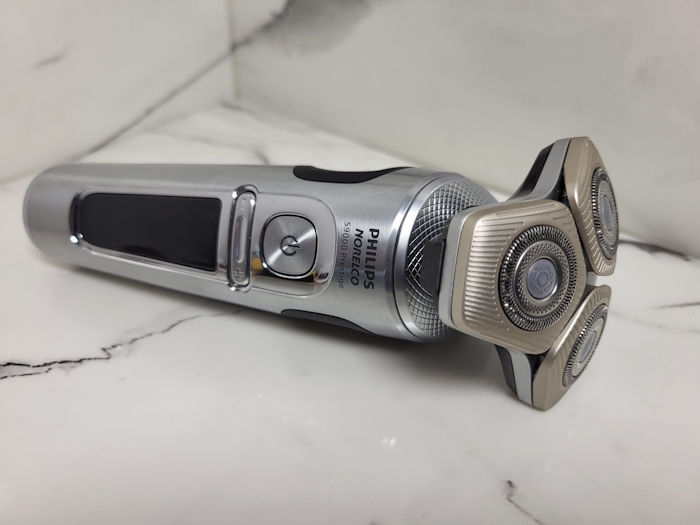
On this occasion, I purchased the Philips (Norelco) SP9841/84 model from the USA. I previously purchased the model that came with the wireless charger (QI Charging Pad), and for this purchase, I wanted the Cleaning Pod instead of the QI Charging Pad.
Upon unboxing, I received the shaver, cleaning pod (with a cleaning fluid refill), travel case, attachable trimmer, small cleaning brush, and user manual.
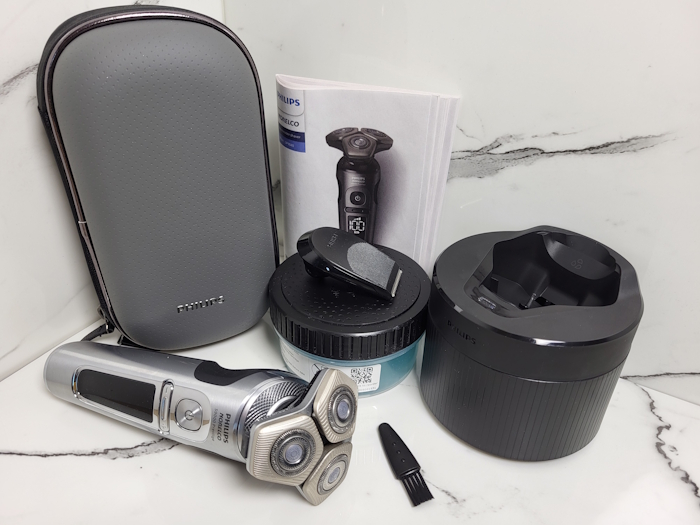
Build Quality, Design, and Ergonomics
Let’s get something I don’t think is great out of the way first, and that’s the plasticky feel about it.
The front section and sides (on the model I have) have a brushed metal look, but it is, in fact, plastic. It would be significantly better in terms of build quality if it were made from a thin aluminum-type metal (I may be expecting too much, or perhaps metal is not the best-suited material).
Build Quality, Design & Ergonomics Ratings
Anyway. It just feels like I should be getting a heavier, stronger feel from a high-end shaver. Perhaps some of you prefer a lighter feel to a shaver, which this one has.
The back of the shaver, which is rubberized for grip, is shaped very well and allows my forefinger to sit snugly. This design, along with the slim tapering down in width feature, makes the Prestige a very comfortable fit in the hand.
Other design features I like include the head section, which we will look at next.
Head and Blade Movement
The head and blade movement works very well in terms of the shaver’s ability to stay close to the skin while shaving over various contours. This flexibility and movement are apparent when I shave over the jaw and chin areas.
Head & Blade Flex
The head can move in all directions while shaving, and each blade flexes (moves back and forth).
I thought the older model was better as the blade sections were rounded (see photo comparison below), and it probably is a slightly better design; however, I have had no issue and cannot see how the flex features of the S9000 could be improved when it comes to actually using and seeing how it functions.
Each head, containing a blade, has lines or guides visible on the front of each blade head (see photo below). They only make sense to me if I am shaving in one direction; otherwise, as I usually do, I shave multidirectionally, and then these do not seem to have a function or go with the grain (oh well, they don’t harm anyway).
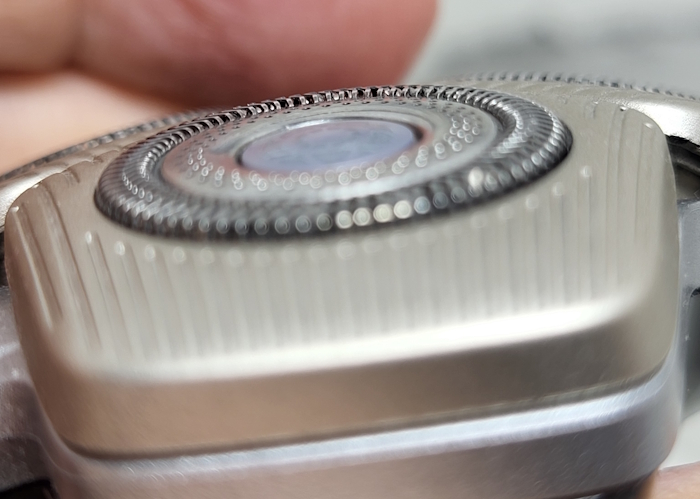
Cutting Actions and Blades
Philips does kind of lay it on thick in the specs with technology jargon, which includes what they have to say about the blades.
Cutting Actions
The Prestige offers up to 165,000 cutting actions per minute (CPM), which means the action of all three blades, considering that each blade head features a dual-track design (two circular blades). The 165,000 CPM is slightly higher for the Prestige than the 150,000 CPM for the Series 9000.
Philips states these NanoTech Dual Precision blades cut up to 25% more hair per stroke** (**vs predecessor). Predecessor, at a guess, must mean the previous Prestige S9000 I used and reviewed with the rounded blade heads.
Philips has a patent on the lift-and-cut design of the blades. Lift and cut is just that; the blades lift hairs to be cut, and the cut is up to 0.00mm (I assume they state up to, as some areas may not shave down to 0.00mm, which is my experience, while other areas shave with a manual razor to a close finish).
The blades also have what Philips states is Hydro SkinGlide coating. This coating is another technical term I cannot prove exists, and I just focus on whether it provides comfort while shaving.
While all these tech terms are appealing and draw us in to want to buy one of these yesterday, the main point is — do these blades cut hair well, comfortably, and quickly enough without leaving too many patches (or at least clearing up patches very well)? The short answer is yes, and the longer answer is in the shaving experience below.
One thing that is apparent to me is that the whole blade system, along with the head flex design, is very well-engineered. That’s very obvious!
Adapts to Beard Density
Many shavers, including the S9000 Prestige, are designed (especially the mid-range and top-end shavers) with technology that supposedly adjusts the shaver’s output based on the coarseness of a person’s growth.
Philips states that their technology reads the beard density 500 times a second. Just that statement alone has the vulnerable marketing part of my mind halfway sold on this shaver.
Marketing or no marketing hype aside, I have no idea if this feature functions. However, my experience shows that the S9000 can be comfortable with less growth and plow through a few days of course growth with ease.
Three Power Modes
The long button on the front of the shaver, marked with a + and -, provides three options for selecting power modes (low, medium, or high speed).
This option can make me question why I need beard density adaptation technology built in, too, but that’s just me being a bit too critical (maybe).
I tried the various modes and found that the lower mode could be useful if I wanted a milder shave while shaving daily to reduce irritation.
I will mostly stick to using a shaver (with this type of power mode option) in full power mode. However, I can see its use for those who want to dial it down a little when shaving frequently. Some guys might shave only on a few days, of course, for growth, and at times shave consecutively daily, then dial it back when they require more comfort and less aggression.
I previously criticized this feature on electric shavers as a gimmick. However, I do now see its potential use, even if it is not for everyone.
Trimmer Attachment
Not having a built-in trimmer on a shaver has its pros and cons. The cons of not having a built-in trimmer and using an attachment like the Prestige are that it requires an extra accessory to carry or move around, and the head must be removed to attach the trimmer.
I can see this aspect of the shaver being a deal breaker for some who find having the built-in trimmer very useful and convenient. Especially for those who always use a trimmer to cut in sideburns and probably have longer hair than I (I’m balding and shave my head).
A pro of the non-built-in trimmer is I believe it enables companies to reduce the size of the shaver, and as we can see with the Prestige, it has a very slim design that enables the shaver to fit snuggly in hand (it’s the same with the current Braun S5, S6, and S7 shavers).
The trimmer is not the best I have used and is in no way as good as a dedicated trimmer. However, it will trim sideburns and remove hairs under the nose adequately before shaving, and that is all it needs to do.
Charging and Battery
The Prestige S9000 models that do not come with the QI pad take an hour to charge fully and provide the user with 60 minutes of runtime. A quick charge of 5 minutes can also provide a shave.
My estimate, without watching the clock, of the above is about right. I got 2 1/2 weeks out of my first full charge, which included a head shave alongside frequent shaving.
I did not receive the QI charging pad with this model, but I can share my experience with the previous Prestige S9000 shaver, which came with the pad.
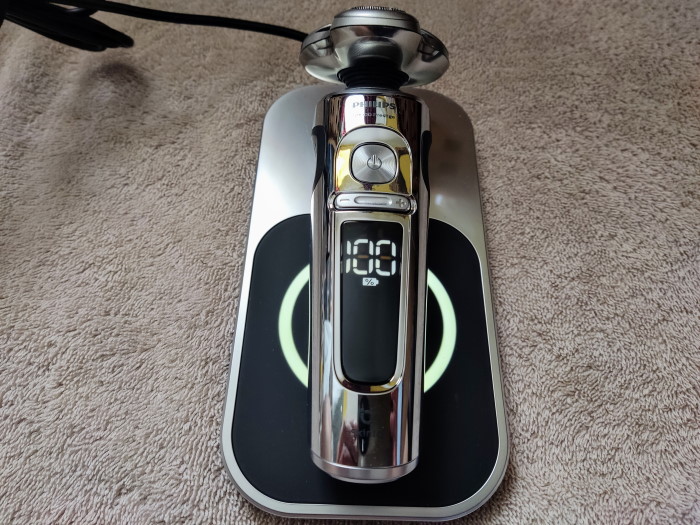
The model that comes with the QI charging pad takes up to 3 hours to charge fully, which may not be favored by everyone. However, I am not going to sit and wait for it to charge, as it’s all about laying it down and coming back when needed.
A nice feature of the QI pad is that after shaving, the shaver can be placed on it to top up the charge. In fact, it is only the first charge that takes so long (3 hours). The obvious thing to do is not to let the shaver battery charge get too low!
The issue with the QI charging pad model, and not an issue with the pad itself, is that it’s the only option available for charging. There is no option to attach a power lead, which I find daft, as I would like to use both the standard 60-minute charge option and the 3-hour wireless pad option.
What if the pad is faulty or I break it (I can’t charge it)? Also, traveling, I might not want to take the pad and want the convenience of just plugging it in.
I had reservations about this Qi Pad, and after a few days, I really grew to like it. However, the lack of a standard charging method lingered in the back of my mind, especially with my older Prestige.
Cleaning and Maintenance
The new design of the head makes it very easy to clean manually, without the need for a cleaning pod that may come with certain model kits. We just touch the button on the front of the shaver head, and the head pops open.
Cleaning & Maintenance Ratings
The head opening and being attached like this is a feature I prefer over the older Prestige style as there is no need to remove the head and keep it separate while it is drying out, among other pros.
When I manually clean it, I simply give the head section a gentle blow and brush out the main debris, then add a few drops of antibacterial soap inside the blades and a few drops of water before letting it run for about 10 seconds with the power switched on. Then, I leave it in an airy spot in my home to let it dry out for a couple of hours or so.
I chose to buy the model that came with the cleaning pod. It’s quite different from the Braun and Panasonic electronic cleaning and charging stations as it is not electrically powered. It does not charge or dry the shaver; it only cleans it.
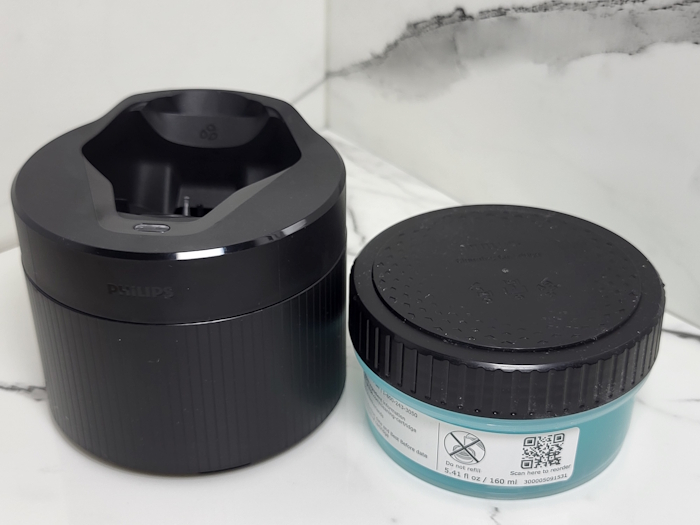
The cleaning pod is useful as it is convenient to just pop the shaver in the pod, let it clean, and then leave it to dry. It will clean it, keep it hygienic, and keep the blades lubricated. The main drawback is the need to replace the cleaning pod cartridges; however, we can purchase alternative cleaning fluids and refill the current cartridge with the new fluid, which is a more cost-effective option.
More about the Philips Quick Clean Pod in this article, including demonstrating a cleaning cycle.
The Prestige features a flip-open head design that makes cleaning easy, so most of us don’t need the cleaning pod; however, it has its advantages, as mentioned.
Philips recommends removing each blade once a month to give the blades a thorough clean. I have taken these out on the old Prestige I have, and after a month, they still looked perfectly clean. However, I guess taking them out once a month, just in case there is any build-up of debris or anything unwanted, is easy enough to do.
These blades are easy enough to remove and replace individually, as they have icon arrows indicating the direction to turn.
I also clean the trimmer blade under running water and apply a spot of oil to keep it lubricated and working well.
I also lubricate each blade with a drop of oil after every three shaves (approx.). Philips does not mention that we should oil the blades, but I do this as a routine to keep them running smoothly and cutting at their best, when not using the cleaning pod and its fluid.
According to the official Philips website, the blades (part number SH91) are recommended for replacement every 2 years. However, the manual suggests that they should be replaced every 12 months. The past advice was 2 years, and I would aim for anything between 1 – 2 years based on how they are performing (if they begin losing effectiveness, then replace before 2 years).
LED Indicators & Travel Lock
We have a numerical percentage indicator that keeps us informed about the amount of charge remaining. This numerical type is the best indicator I have found on shavers, and I find it useful. We get a red battery icon that lights up when we are down to the last 10% of charge left to inform us to get a charge on asap.
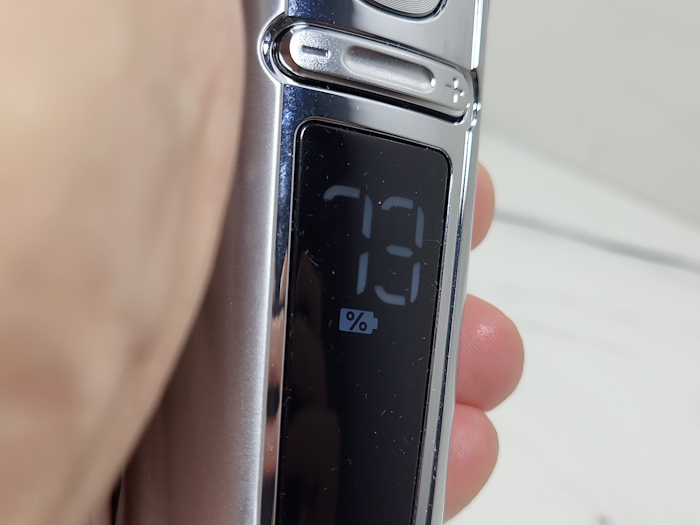
We have other usual indicators that let us know when to clean it, replace the heads, unplug it when it is in use (i.e., it does not work when on charge), power model levels, and the charging symbol.
A couple of other useful indicators I have never paid attention to before are the overheating and blocked head indicator symbols. They both do just that: one indicates the shaver has overheated during charging, and the other responds to dirty, blocked, or damaged heads.
I like how the percentage indicator lights up automatically when I pick up the shaver, as it reminds me of the remaining charge. As far as I know, this feature is not on the models that come with the QI charging pad.
This automatic charge indicator can be very sensitive when picking up the shaver, and I notice it comes on even when I knock on the surface it is sitting on. I thought about this feature while traveling and whether it would discharge the battery in transit (a bit of an overconcern, I suppose), but we can activate the travel lock. While the travel lock will light up when we move the shaver or pick it up, it uses very little battery charge.
The useful travel lock is activated by holding the power button for three seconds, which is displayed on the LED screen, and then holding it for another three seconds to deactivate the lock.
Accessories
I have already mentioned enough about the QI charging pad and the non-electrical cleaning pod, which should give you an idea of whether you want a model that includes either of these features in the kit.
Some models, including mine, come with a decent but quite large travel case. I fit everything inside it easily enough, apart from the cleaning pod, of course.
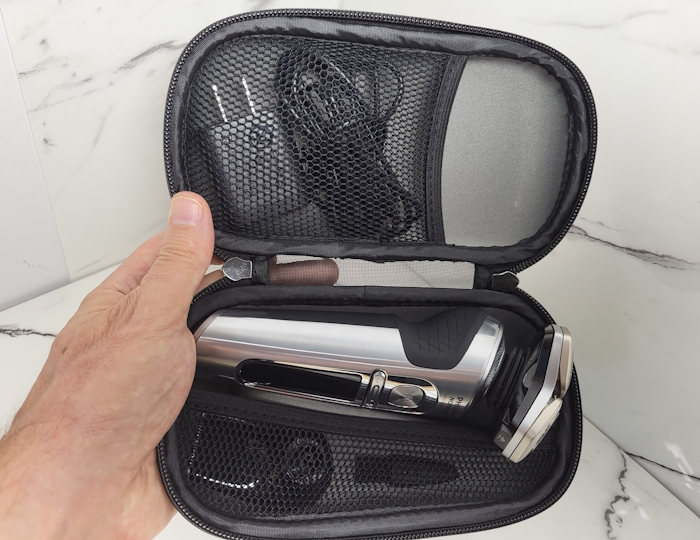
We all get the attached trimmer, no matter which kit we purchase. Some kits also come with a trimmer guard for beard trimming (see photo below of my previous one) and a nose trimmer, but these are generally accessories I have no interest in (especially if it bumps up the cost).
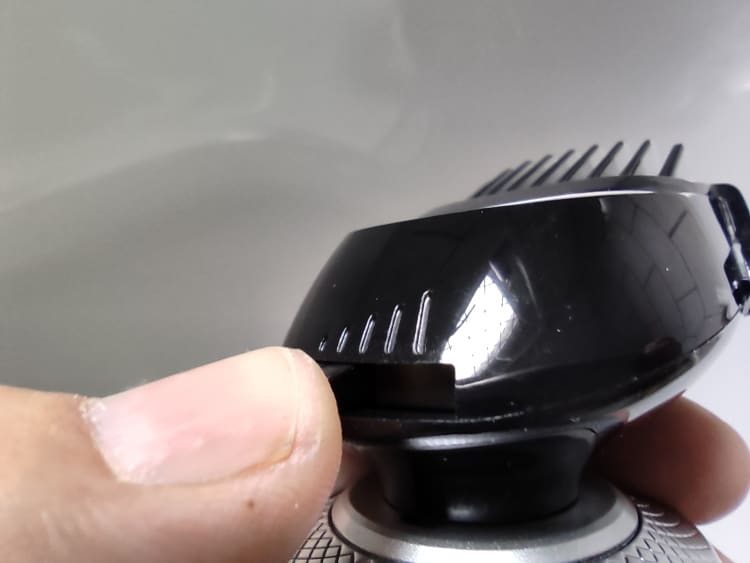
I generally opt for the kit and model that comes with the most accessories, but this is partly due to reviewing shavers for you to test out. I have had the QI charging pad kit model, and this model has the cleaning pod. I would be happy to have both items in one kit, which can be purchased as I like both accessories.
If cutting costs were important, I would opt for the cheapest available option, even without the charging pad and cleaning pod, as both cleaning and charging can be easily done without these gadgets. Just keep in mind, though, that the price difference is not always that significant between shavers with and without accessories.
Shaving Experiences
I used the latest Prestige S9000 model on various levels of growth to assess its performance, and I also did a wet shave test.
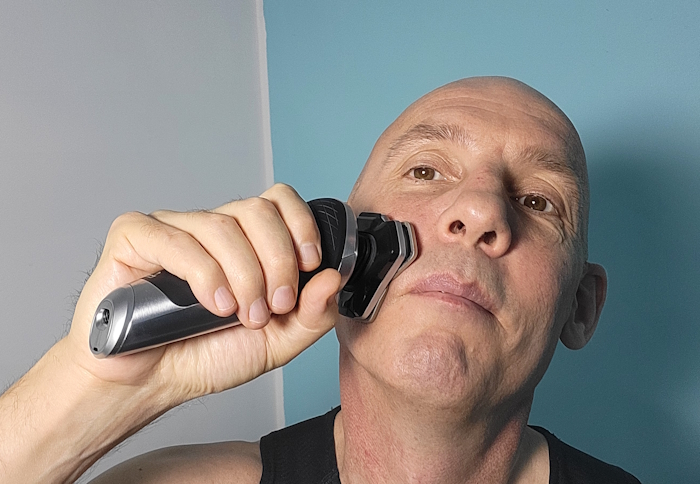
I shaved with four days of growth, which was the maximum I would shave before getting a beard trimmer out to trim before shaving. The shaver performed well and efficiently over the four days.
I did feel a couple of hair pulls during the four-day growth-shaving session—nothing drastic, but worth mentioning.
As a standard for my skin and growth type, the shaver performed very well on two and three-day growth. Quick shaves that were comfortable!
I tried shaving consecutively for three days daily, and this gave me the opportunity to try out the lower power mode option. That lower power mode felt as though it reduced the irritation I would normally get when shaving on the third consecutive day.
Contouring
I am a big fan of how the recent heads and blades of the Prestige and other Philips shavers, including the Philips S5000, move along the various contours very well.
When shaving over the jaw and chin lines, the shaver blade system stays close to the skin.
Throughout the shave, the blades stay close to my skin, and I can’t see how they could be improved. I state this even after using the older Prestige with rounded blade heads, as in actual use; these new angular types with flex work very well.
Comfort
For me, comfort while shaving is at the top of my requirements and comes above ultra closeness, and this is where Philips shavers step in. Philips shavers, including this Prestige, provide more comfort than most other shavers.
While I can feel the Prestige is more aggressive than the S5000, which I recently used and reviewed, it still provides a comfortable shave. We have the option to dial down the power to mid or low if it feels too aggressive on any occasion, which I find to be a useful option.
Tricky Hairs and Leftovers
I had minimal hair left on my sideburns and the bottom corner of my jaw area, which are my standard areas prone to leftover hair. The great thing is that the Prestige cleared up these very quickly.
I had no tricky, long, or flat-laying hair issues at all with this shaver. I just don’t get them with this shaver.
Speed and Closeness
All shaving experiences were done pretty quickly. We are talking about a few minutes or so for three days of growth and a couple of minutes shaving with two days of growth.
The speed also includes the lack of time needed to clear up patches that I spend when using foil shavers, which even the Panasonic Arc 5 and Braun Series 9 Pro give me trouble with.
Shavers like the Panasonic Arc 5, Arc 6, and Braun Series Pro do give me just a tad more of a closer shave, but other pros and cons come into play between all these shavers.
Wet Shaving
I tried out wet shaving as I usually do for testing purposes and to give you guys feedback.
The shave felt comfortable when using traditional shaving cream lather and the shaver.
There was no additional comfort and no added discomfort, so if you use electric shavers for wet shaving, then it should work fine with most shaving lubricants. Just dont expect any major changes, based on my experience.
Overall Shaving Performance Ratings
Value for Money
Currently, we are looking at paying around $300, £300, or €300 (plus or minus some), which is about the price range for the top-end shavers from the three top brands (i.e., Braun, Panasonic, and Philips).
Value for Money Ratings
I would like to see one at around $270 with accessories like the QI pad and cleaning pod, and then one available without the accessories for around $240, which would make it a shaver at a good price point.
Please note that the SH91 replacement blades, which are recommended to be replaced every 12 -24 months, cost approximately $40-$60, £45-£60, or €45-€65.
Final Thoughts – Verdict (Worth Buying?)
Over the years of using and reviewing these electric shavers, I have recently been drawn to getting a more comfortable shave, as opposed to the closest shave. This preference for comfort has led me to favor all Philips shavers, as they are all more comfortable when measured side by side within each series.
The Prestige S9000 follows this comfort factor of other Philips shavers but with some additional aggressiveness, which speeds up the shave and gets that bit closer, a bit quicker than others. It is also more suitable than some other Philips shavers for shaving on coarse growth of about four days.
The other factor leaning me towards Philips is having fewer leftovers and no tricky hairs being left, while being able to clear up any patches quicker than their competitors’ shavers.
If I were budgeting somewhat, then I would be looking at cheaper options like the Philips 7000 Series or even the Series 5000, and take the lower performance that comes with those (not massive differences and still good options).
Now, my experience may not be the same as yours or that of others, so you may take some of this as subjective and consider the need for you to have your own experiences.
If I did not have issues with tricky and leftover hair with foil shavers (think Braun) as much as I do with rotary-style shavers, then other high-end shavers, such as the Braun Series 9 Pro or Panasonic Arc 5, with their additional closeness and aggressiveness, would be shavers to compare and consider.
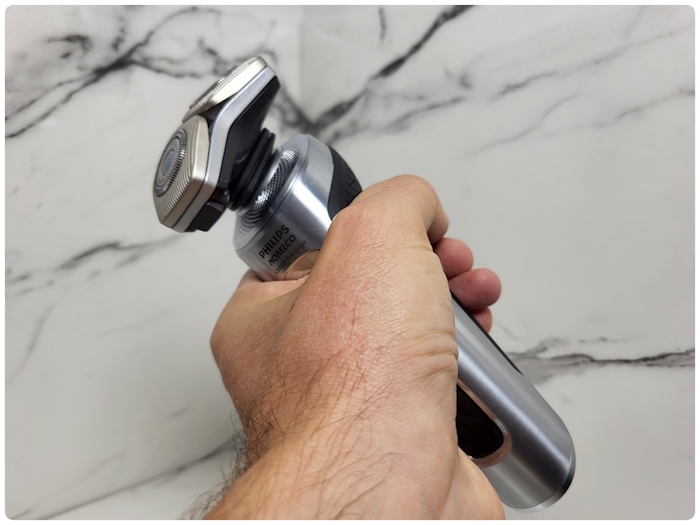
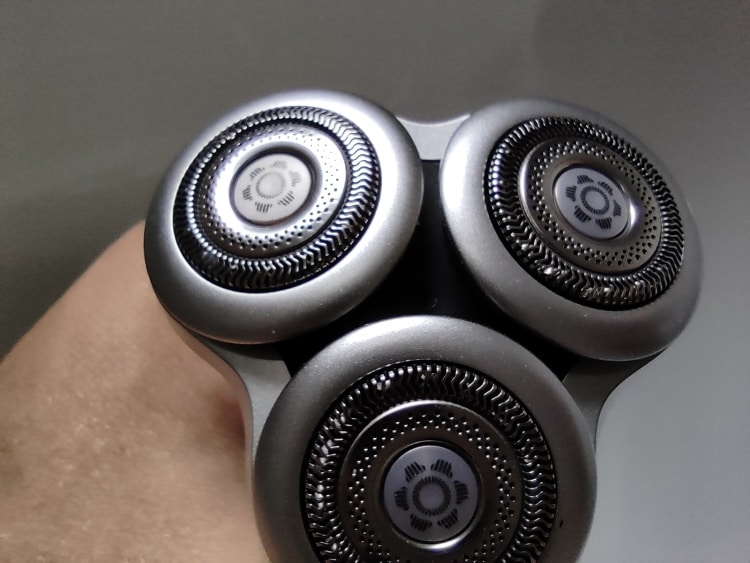
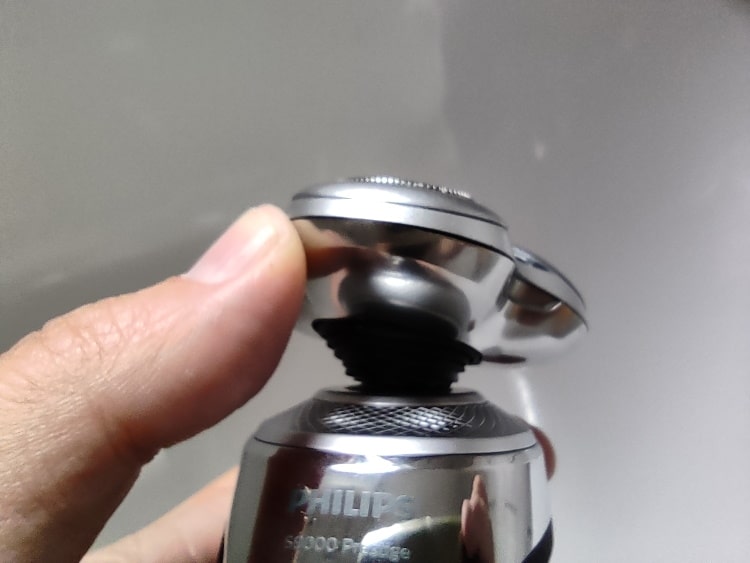
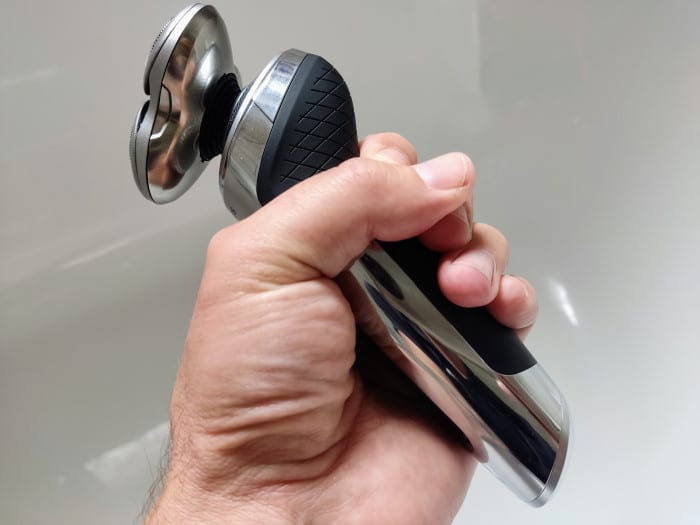
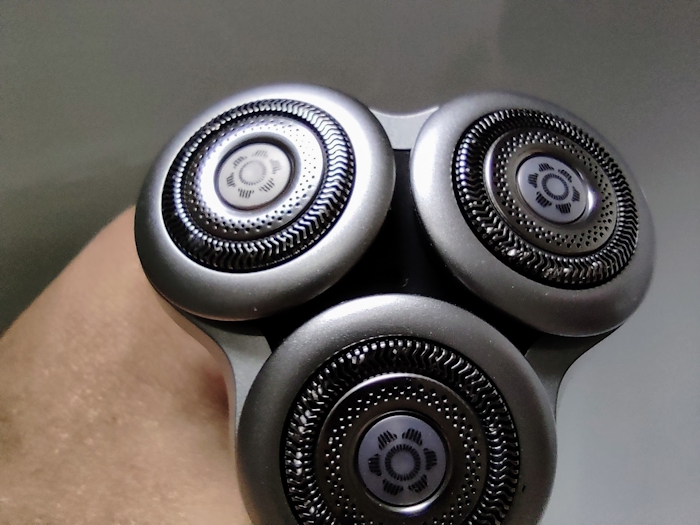
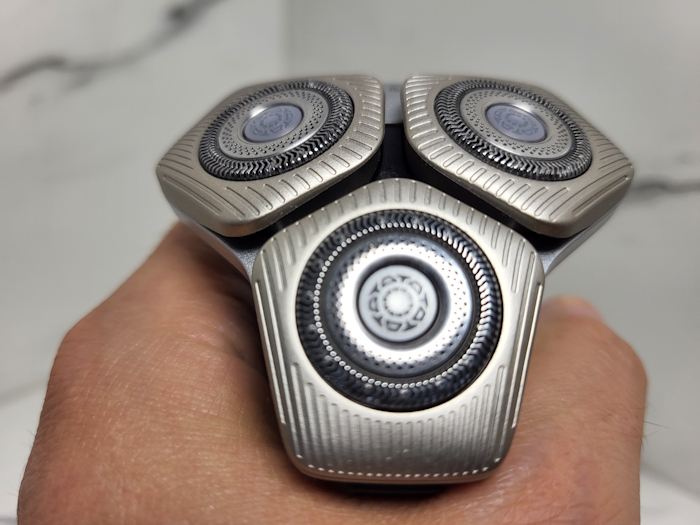

Hi Jason,
I noticed in your review of the S9000 Prestige, you shave your head and your face in straight strokes. Over here in Singapore, Philips recommends shaving in circular strokes.
What has been your experience please?